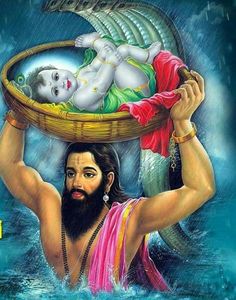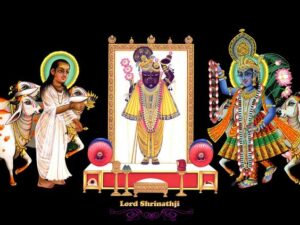Introduction
In the city of Nathdwara, located in Rajasthan, India, there is a famous temple called Shrinath Ji Mandir. This temple is dedicated to Lord Krishna, also known as Shrinaji, and it holds great significance among the people of Rajasthan. The idol of Lord Krishna in this temple is believed to be self-manifested, making it a unique and revered place of worship. The temple complex also includes the havali (residence) of Lord Krishna, where devotees come to offer their prayers and witness the divine Govardhan Leela, a significant event in Lord Krishna’s life.
The Story of Govardhan Leela
Many years ago, in the town of Vrindavan, there was a tradition of worshipping Indra, the king of gods, and performing grand celebrations in his honor. These celebrations included offerings and prayers to appease Indra, who was believed to be responsible for the rainfall and the fertility of the land. However, when Lord Krishna came to Vrindavan, he questioned the necessity of this tradition.
Lord Krishna, along with the people of Vrindavan, understood that it was not Indra but the land itself that provided everything they needed. They realized that their crops grew, their cattle thrived, and their lives flourished because of the blessings of Mother Earth. So, Lord Krishna decided to change the focus of the celebrations from Indra to Govardhan Parvat, a sacred hill that provided shelter and sustenance to their livestock.
The Significance of Govardhan Puja
From that day onwards, the people of Vrindavan started worshipping Govardhan Parvat instead of Indra. They would decorate the hill with flowers and offer prayers to it. According to the legend, Lord Krishna lifted Govardhan Parvat with his little finger to protect the people and their livestock from the wrath of Indra, who was angered by this shift in devotion. Indra, in his fury, sent heavy rain and storms to destroy the town.
But Lord Krishna, with his divine powers, protected the people by providing them shelter beneath the lifted hill. The rain poured for days, but the people of Vrindavan remained safe. It is said that the rainwater brought about by Indra’s anger filled the entire town and submerged it. However, the devotion and faith of the people saved them from any harm.
The Lesson Learned
This incident taught the people of Vrindavan a valuable lesson. They realized that the true power lies not in external forces but within themselves and the land they live on. They understood that by worshiping nature and acknowledging its importance, they could protect themselves from any calamity. This revelation shifted their perspective and strengthened their bond with the environment.
Since then, every year, the festival of Govardhan Puja is celebrated with great enthusiasm in Vrindavan. The devotees come together to express their gratitude to Mother Earth for providing them with sustenance and protection. They build replicas of Govardhan Parvat using cow dung and decorate them with flowers and colorful powders. The puja is performed with devotion and reverence, and it is believed that by performing this ritual, one can receive blessings for prosperity and abundance.
Conclusion
Diwali, Janmashtami, Holi, and Govardhan Puja are significant festivals celebrated in Vrindavan. However, Govardhan Puja holds a special place in the hearts of the people. It reminds them of the importance of nature and the need to protect and nurture it. The story of Govardhan Leela teaches us that true power lies in recognizing and appreciating the resources that the Earth provides us.
As we celebrate Govardhan Puja this year, let us remember the lesson it imparts and strive to live in harmony with nature. Let us be grateful for the abundance it offers and work towards preserving it for future generations.



